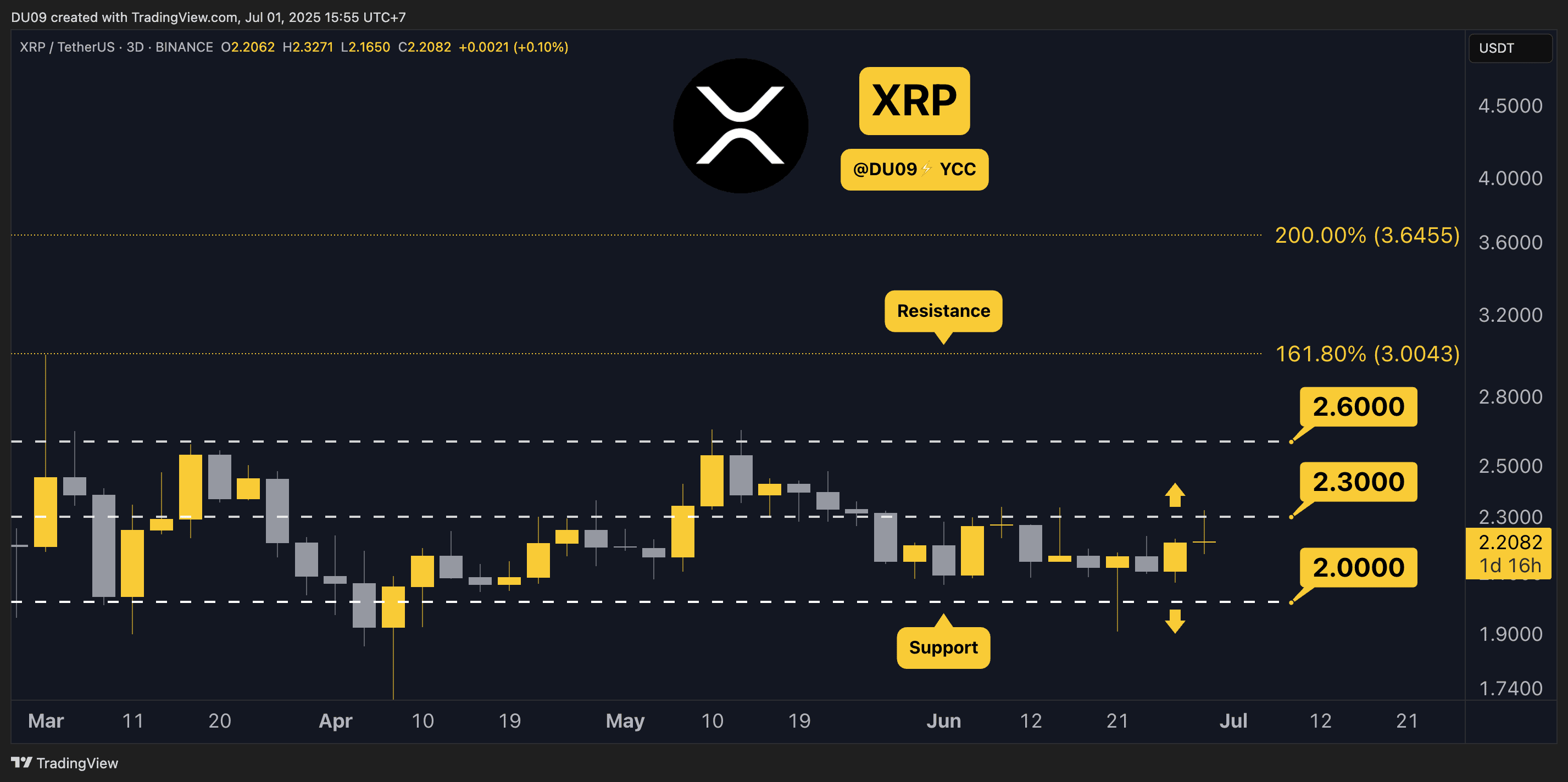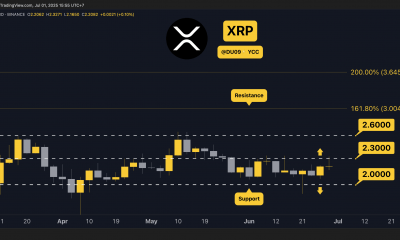Cryptocurrency
Long and short positions, explained

The concept of long and short positions
The long and short positions represent opposite strategies that investors and traders use to speculate on the price movements of assets under consideration.
The idea of long and short positions is still applicable to traditional financial markets in the realm of cryptocurrencies. In order to profit from a cryptocurrency’s price increase, a long position entails purchasing it with the expectation that its value will rise over time.
In contrast, going short in the cryptocurrency market means selling a cryptocurrency one doesn’t own in anticipation of a price reduction, then buying it back at a cheaper cost to close out the position and profit from price drops.
Crypto traders and investors employ these strategies to navigate the highly volatile and speculative nature of digital assets and seize opportunities in both bullish and bearish market conditions.
The fundamental distinctions between long and short positions
In cryptocurrency trading, a long position is started by purchasing an asset in the hope that its price will rise, whereas a short position is started by disposing of an asset (typically one that was borrowed) in the hope that its price will fall.
While closing a short position means purchasing the asset at a lower price to achieve gains, exiting a long position involves selling the asset at a higher price to lock in profits. Entry and exit points are essential for these tactics to be implemented successfully.
Understanding the differences between long and short positions in the world of cryptocurrency trading is essential for successfully navigating the volatile digital asset markets. Here’s a summary of the differences between the two:

The process of going long in cryptocurrency
Going long in cryptocurrency involves a strategic process to profit from anticipated price increases.
Here’s a step-by-step process:
Research and analysis
Before making any investment, a person must carefully investigate and analyze their chosen cryptocurrency. Consider elements like its technology, market trends, historical data and likelihood of acceptance.
Select a crypto exchange
The traders must then pick a trustworthy cryptocurrency exchange or trading platform that provides the required cryptocurrency. They should set up an account, carry out the required checks and use two-factor authentication to protect the account.
Deposit funds
The next step after creating an account is to deposit money into it. Depending on the platform, users can often deposit fiat money or another cryptocurrency to be used to buy the desired coin.
Place a buy order
Placing a “buy” order on the platform of choice for the cryptocurrency is the next step. Users can either choose the current market price or a limit order with a specific purchase price.
Monitor and manage
After the buy order is carried out, an individual owns the cryptocurrency. They should carefully monitor market developments and choose an exit strategy, which can entail deciding on a price objective, relying on technical indicators or meeting other requirements. When it’s time to sell their long position and convert the cryptocurrency to their preferred currency, they can place a “sell” order.
Risks and potential rewards associated with long positions
Long positions in cryptocurrencies offer the potential for significant profits through price appreciation, but they are accompanied by the substantial risk of market volatility and potential losses.
Although they carry some risk, long positions in cryptocurrencies have the potential to yield significant gains. The chance to profit from price growth is the main benefit. For instance, an investor who purchased Bitcoin (BTC) at a discount and kept it during its sharp increase in value realized large gains.
Long positions can expose investors to the developing cryptocurrency ecosystem and may profit from the uptake of blockchain technology. However, the risks are equally pronounced. Cryptocurrencies are well-known for being extremely volatile and prone to sudden price changes.
If the market goes bearish and the value of investors’ holdings declines, they could lose money. Prices can also be impacted by regulatory uncertainty, security breaches and market sentiment.
As cryptocurrency markets are subject to protracted periods of instability and unfavorable trends, maintaining a long position needs patience. Investors must do in-depth research, exercise risk management and stay educated to make informed decisions when pursuing long positions in cryptocurrencies.
The process of going short in cryptocurrency
In cryptocurrency, going short includes betting on a price decrease and making money off of it.
Here’s a step-by-step process:
Research and analysis
A trader starts by thoroughly researching and analyzing the cryptocurrency they want to sell. They seek signs that an asset’s value may be declining, such as unfavorable news, overvaluation or technical indicators pointing to a bearish trend.
Select a trading platform
Traders pick a trustworthy cryptocurrency exchange or trading platform that provides margin trading or short-selling alternatives for the particular cryptocurrency they want to short.
Margin account setup
The trader opens a margin trading account on the chosen platform, goes through any necessary identification verification steps, and deposits fiat money or cryptocurrencies to use as collateral. This collateral is necessary to protect against potential losses when holding a short position.
Borrow cryptocurrency
To sell a cryptocurrency short, a person must borrow it from an exchange or other platform users. This borrowed cryptocurrency is then sold on the open market.
Monitor and set limits
The trader carefully monitors the crypto market to watch price changes. They established a target buy-back price and placed stop-loss orders to prevent further losses. They intend to buy back the borrowed cryptocurrency to close off their short position at this target price.
Close the position
When the anticipated price decline of the cryptocurrency occurs, the trader closes the position by purchasing the borrowed cryptocurrency at a lower price to return it to the lender and profit from the price decline. This action marks the completion of the short position.
Risks and potential rewards associated with short positions
By betting on price reductions, short positions in cryptocurrencies may yield rewards, but they also come with significant risks due to market volatility, endless potential for loss and unforeseen price increases.
Short positions in cryptocurrency trading have a high potential for gains but also pose substantial risks. The main benefit is the chance to profit from a cryptocurrency’s price drop. For example, if a trader accurately foresees a bearish trend and shorts a cryptocurrency like Bitcoin, they may then purchase it back at a lower price and keep the profit from the price difference.
Short investments, however, often pose several significant risks. The markets for cryptocurrencies are notorious for their high volatility, and unanticipated price increases could result in large losses for short sellers.
There is also the limitless risk aspect to consider because there is no cap on how much the price might increase. Sharp price increases can be brought on by legislative changes, unanticipated shifts in market sentiment or unexpected positive news.
Short-selling in cryptocurrencies necessitates exact timing, meticulous risk management and continuous market monitoring to successfully negotiate the inherent volatility and maximize potential gains while limiting losses.
Tax implications associated with gains and losses in long and short positions
Tax ramifications for gains and losses in long and short cryptocurrency holdings can be complicated and vary by country.
Gains from long positions are typically regarded as capital gains in many nations, and when the asset is sold, capital gains taxes may apply. Short-term gains are taxed more than long-term gains, and the tax rate frequently varies depending on the holding time.
Conversely, short positions may present particular tax difficulties. The act of borrowing and selling a cryptocurrency short may not result in an immediate tax obligation in some countries because the short position is not closed until the borrowed asset is bought back. The trader may experience capital gains or losses when closing out a short position, depending on the discrepancy between the selling and buying prices.
To understand and abide by local tax laws, cryptocurrency traders should be aware of crypto tax laws applicable in a particular jurisdiction, as the tax treatment of cryptocurrency gains and losses can differ dramatically from one location to the next. Also, proper record-keeping and reporting are crucial to maintaining tax compliance in the cryptocurrency sector.
Cryptocurrency
3 Things to Watch in Ripple’s (XRP) Price Today

XRP is testing the resistance at $2.3. Will it break?
Key Support levels: $2
Key Resistance levels: $2.3, $2.6, $3
1. Key Resistance Under Pressure
Yesterday, buyers pushed XRP to the key resistance at $2.3, but sellers returned to stop a breakout. At the time of this post, the price is in a pullback. Nevertheless, this is a positive sign that shows buyers are returning. If this bullish momentum intensifies, then $2.3 could fall and be followed by a test of $2.6 next.
2. Optimism Returns
With the price keen on making higher highs, optimism is returning to this cryptocurrency. This can be seen on the volume profile where buyers have dominated in the last few days. A break above $2.3 will likely see the volume spike and allow further price expansion into new highs.
3. MACD Turning Bullish
After the daily MACD turned positive last week, the 2-day MACD has also turned bullish today. This shows that the buy momentum is slowly creeping into higher timeframes which will build confidence in the price action and attract more buyers. With a positive feedback loop in action, XRP has a good shot at $2.6 or even higher in July.
Binance Free $600 (CryptoPotato Exclusive): Use this link to register a new account and receive $600 exclusive welcome offer on Binance (full details).
LIMITED OFFER for CryptoPotato readers at Bybit: Use this link to register and open a $500 FREE position on any coin!
Cryptocurrency
Bitcoin Traders Wait Important Economic Announcements Today, These Altcoins Plummet (Market Watch)

Bitcoin’s price has retraced by a slight 0.9% in the past 24 hours as traders are expecting a few important economic events during today’s session.
Meanwhile, the broader cryptocurrency market is also reflecting the uncertainty as the majority of altcoins are trading in the red with some charting a lot bigger declines than others.
Bitcoin Price Waits for News
The deep involvement of corporate Bitcoin buyers and institutions has surely played a major role in its price increase over the past year but it’s also the reason why the crypto market has been largely correlated to traditional ones.
A few years ago, literally nobody cared about metrics such as CPI, PMI, and whatnot, but now every crypto trader has them on their watchlist.
As such, today is also shaping up to be a volatile experience with a few important economic events on the calendar.
First, Jerome Powell will speak in the afternoon, followed by data for job openings, PMI, and ISM manufacturing – all indicators that shape policymaking, especially when gauging the strenght of the local economy.
That said, Bitocin’s price is down about 1% on the day and is currently trading at around $106,500 after having tested $109,000 yesterday. It’s interesting to see if the bulls have it in them to push bakc towards the upper boundary of the recent trading range or if the bears will send the price back below $105K.
Altcoins in Red, Some More Than Others
As you can clearly see in the heatmap below, the altcoins are also not having a great day. This is, perhaps, to be expected – Bitcoin’s dominance over the market has been rising gradually over the past many months and whenever BTC slips, altcoins crash.
The past 24 hours have hardly been a crash, though, but it’s clear that most of them are charting more considerable declines.
This is especially true for TKX, ARB, SPX6900, SEI, and others, that are down between 8% and 15% on the day.
Believe it or not, Bitcoin Cash (BCH) is today’s best performer, gaining more than 6%. Who would have thought?
Binance Free $600 (CryptoPotato Exclusive): Use this link to register a new account and receive $600 exclusive welcome offer on Binance (full details).
LIMITED OFFER for CryptoPotato readers at Bybit: Use this link to register and open a $500 FREE position on any coin!
Disclaimer: Information found on CryptoPotato is those of writers quoted. It does not represent the opinions of CryptoPotato on whether to buy, sell, or hold any investments. You are advised to conduct your own research before making any investment decisions. Use provided information at your own risk. See Disclaimer for more information.
Cryptocurrency charts by TradingView.
Cryptocurrency
How Much You Should Invest in Bitcoin (BTC)? Veteran Trader Peter Brandt Weighs in

TL;DR
- The expert advises monthly investments in SPY and BTC for long-term success.
- The leading cryptocurrency is up 6% this week and trades near $108,000. Analysts are split – some see a breakout to $130K – $200K if key resistance levels are cleared, while others warn of a possible drop to $100K or even $95K if momentum fades.
‘Trading is the Wrong Path’
Besides its fundamentals and ability to transform the global financial system, Bitcoin (BTC) has proven to be an excellent investment opportunity.
At least, that was the case in the past few years: the asset went through multiple bear and bull markets to eventually cross the $100,000 mark. Currently, it trades at around $108,000 (according to CoinGecko’s data), representing a 75% increase on a yearly scale and a substantial 43,000% jump compared to its valuation a decade ago.
But does the leading cryptocurrency remain a good investment after this major rally over the years, and how much should people allocate to it? That’s a question many people are trying to figure out.
It seems that there isn’t a direct answer, and it all depends on the risk profile of the investors, as well as other important factors. However, one can turn to certain experts who are experienced enough to give guidance.
An example is the veteran trader Peter Brandt, who recently suggested that approximately 95% of people fail when trading. Instead, he advised them to excel in their regular jobs, prioritize their families, and invest in homeownership. Last but not least, Brandt recommended making monthly investments, allocating 80% of the amount to SPY (the ETF that tracks the S&P 500 Index) and 20% to BTC.
Trading is the wrong path for 95% of ppl
Most would be better off becoming excellent at a day job (engineer, plumber, welder, vet, sales)
Live economically
Get married, have kids
Buy a twin home – rent out one of them
Invest monthly – 80% in $SPY and 20% in Bitcoin— Peter Brandt (@PeterLBrandt) June 29, 2025
The Next Potential Targets
Let’s now take a closer look at BTC’s recent performance and explore its chances for a further pump in the short term. The asset has increased in value by approximately 6% over the past week, with numerous analysts predicting a surge to a new all-time high if certain conditions are met.
The X user Cipher X believes “a strong weekly close” above $107,720 could open the door to a further rally to as high as $130,000-$135,000 in Q3 2025.
“Just look at Q4 2024 chart and you’ll see what happened when BTC had its biggest weekly close,” they added.
Merlijn The Trader thinks the final pump for this bull run is coming, envisioning a fresh ATH of around $200,000 towards the end of the year. At the same time, he advised investors to take profits, anticipating a drastic pullback to $95,000 shortly after that.
On the contrary, Ali Martinez argued that the cryptocurrency currently faces a key rejection while the stochastic RSI flashes a death cross on the daily chart. The analyst thinks a plunge to $100,000 is not out of the question unless “we get a sustained close” above $109,000.
Binance Free $600 (CryptoPotato Exclusive): Use this link to register a new account and receive $600 exclusive welcome offer on Binance (full details).
LIMITED OFFER for CryptoPotato readers at Bybit: Use this link to register and open a $500 FREE position on any coin!

 Forex3 years ago
Forex3 years agoForex Today: the dollar is gaining strength amid gloomy sentiment at the start of the Fed’s week

 Forex3 years ago
Forex3 years agoUnbiased review of Pocket Option broker

 Forex3 years ago
Forex3 years agoDollar to pound sterling exchange rate today: Pound plummeted to its lowest since 1985

 Forex3 years ago
Forex3 years agoHow is the Australian dollar doing today?

 Cryptocurrency3 years ago
Cryptocurrency3 years agoWhat happened in the crypto market – current events today

 World3 years ago
World3 years agoWhy are modern video games an art form?

 Commodities3 years ago
Commodities3 years agoCopper continues to fall in price on expectations of lower demand in China

 Economy3 years ago
Economy3 years agoCrude oil tankers double in price due to EU anti-Russian sanctions

























